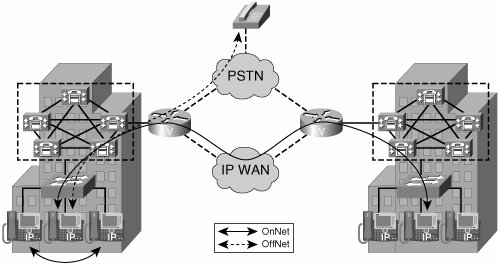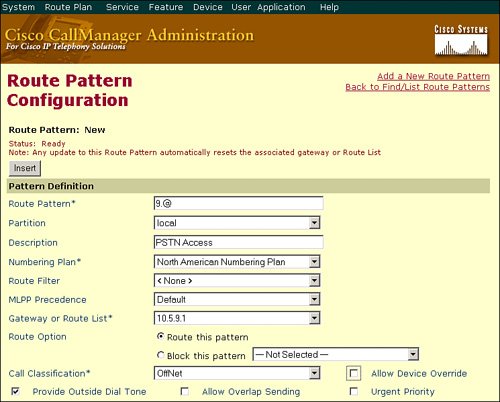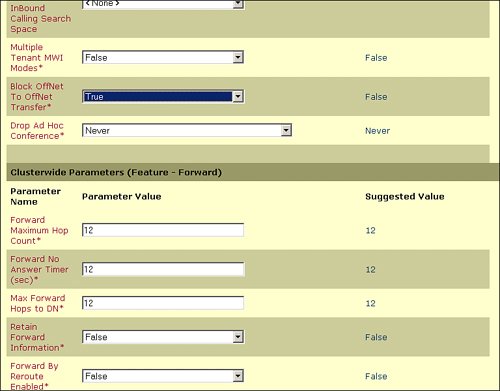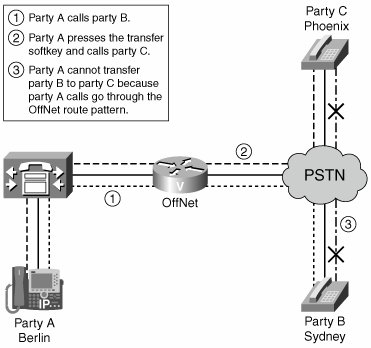Restricting External Transfers
Call transfer is typically a feature that employees use to transfer from internal DNs to internal DNs. When calls are transferred to an external destination, very often the reason is that the caller whose call is transferred does not have permission to dial that external destination. The operator or an employee, for instance, could be asked to transfer a call of a colleague who is home on vacation to an international destination. Or an employee who is not allowed to call international numbers could ask a colleague who is allowed to call international numbers to transfer the call to that international number. An employee could also save money by having family members call the employee in the office when they need to place costly calls. All that the employee has to do is to transfer the call for them. To eliminate the cost of their call to the office of the employee, the employee could even hang up and call them back before transferring the call.
You can configure Cisco CallManager to block external-to-external call transfers. This configuration involves setting a simple service parameter and configuring gateways, trunks, and route patterns as OffNet (external) devices. After you have configured this, external-to-external call transfers will not be allowed. This feature provides an OnNet or OffNet alerting tone to the terminating end of the call (determined by the configuration of the device as either OnNet or OffNet). For incoming calls, trunks or gateways determine OffNet versus OnNet classification. For outgoing calls, the route pattern determines OffNet versus OnNet status.
Note
The external call transfer restriction requires the Cisco CallManager Release 4.1 or later software component.
Defining OnNet and OffNet
Cisco CallManager classifies internal and external calls as OnNet and OffNet. A call coming from an external PSTN is classified as an OffNet call. A call that is placed internally (from one telephone to another, or between two Cisco CallManager clusters, where the call is routed over the WAN) is classified as an OnNet call, as illustrated in Figure 22-5. When you are using Automated Alternate Routing (AAR) in OnNet or OffNet implementations, it is important to know from where the call is coming. With AAR, the source can be either the WAN connection or the PSTN connection. This can cause restrictions when a call is rerouted. For example, if a user attempts to call across the IP WAN and AAR reroutes the call through the PSTN, the called party will not be able to transfer the call to another external phone number due to the Block OffNet to OffNet Transfers service parameter.
Figure 22-5. OnNet Versus OffNet Calls

You can configure gateways and trunks as OnNet (internal) or OffNet (external) by using gateway configuration, using trunk configuration, or setting a clusterwide service parameter to classify devices automatically. When the feature is used in conjunction with the clusterwide service parameter Block OffNet to OffNet Transfer, the configuration determines whether calls can transfer over a gateway or trunk.
These devices can be configured as OnNet and OffNet to Cisco CallManager, as shown in Figure 22-6:
- H.323 gateway
- Media Gateway Control Protocol (MGCP) Foreign Exchange Office (FXO) trunk
- MGCP T1/E1 trunk
- Intercluster trunk
- Session Initiation Protocol (SIP) trunk
Figure 22-6. Configuring a Gateway as OnNet or OffNet

By default, all gateways use OffNet classification.
To classify an outgoing call as OnNet or OffNet, you can set the Call Classification field in the Route Pattern Configuration window to OnNet or OffNet, as shown in Figure 22-7. You can override the route pattern setting and use the trunk or gateway setting by checking the Allow Device Override check box in the Route Pattern Configuration window. All route patterns default to OffNet if the Provide Outside Dial Tone check box is checked. If the check box is unchecked, the route pattern defaults to OnNet.
Figure 22-7. Configuring a Route Pattern as OnNet or OffNet

Configuring Call Transfer Restrictions
Now that you have seen the method used to categorize gateways and route patterns, you can complete these steps to block external calls from being transferred to external devices:
|
Step 1. |
You can specify the OnNet or OffNet classification on the following:
|
|
Step 2. |
For incoming calls, configure individual gateways or trunks as OffNet. |
|
Step 3. |
For outgoing calls, configure the route pattern Call Classification field as OffNet. Note that you can choose the Allow Device Override check box under the route pattern to allow the associated gateway to dictate whether the outgoing call is OnNet or OffNet. |
|
Step 4. |
Set the Block OffNet to OffNet Transfer clusterwide CallManager service parameter shown in Figure 22-8 to True. Figure 22-8. Setting the Block OffNet to OffNet Service Parameter 
|
Call Transfer Restriction Example
In the Cisco CallManager configuration shown in Figure 22-9, the route pattern that is used to reach the external destinations is classified as an OffNet pattern. The gateway is also classified as OffNet. The service parameter Block OffNet to OffNet Transfer in the Cisco CallManager service parameters is set to True. Thus, the attempt by party A to call party B and transfer the call to party C will not work because OffNet-to-OffNet call transfers are restricted.
Figure 22-9. Blocking OffNet-to-OffNet Calls

Dropping Conference Calls |
Part I: Cisco CallManager Fundamentals
Introduction to Cisco Unified Communications and Cisco Unified CallManager
Cisco Unified CallManager Clustering and Deployment Options
- Cisco Unified CallManager Clustering and Deployment Options
- The Two Sides of the Cisco Unified CallManager Cluster
- Cluster Redundancy Designs
- Call-Processing Deployment Models
- Summary
- Review Questions
Cisco Unified CallManager Installation and Upgrades
- Cisco Unified CallManager Installation and Upgrades
- Cisco Unified CallManager 4.x Clean Installation Process
- Upgrading Prior Cisco Unified CallManager Versions
- Summary
- Review Questions
Part II: IPT Devices and Users
Cisco IP Phones and Other User Devices
Configuring Cisco Unified CallManager to Support IP Phones
- Configuring Cisco Unified CallManager to Support IP Phones
- Configuring Intracluster IP Phone Communication
- IP Phone Configuration
- Case Study: Device Pool Design
- Summary
- Review Questions
Cisco IP Telephony Users
- Cisco IP Telephony Users
- Cisco CallManager User Database
- Cisco CallManager User Configuration
- User Logon and Device Configuration
- Summary
- Review Questions
Cisco Bulk Administration Tool
- Cisco Bulk Administration Tool
- The Cisco Bulk Administration Tool
- Using the Tool for Auto-Registered Phone Support
- Summary
- Review Questions
Part III: IPT Network Integration and Route Plan
Cisco Catalyst Switches
- Cisco Catalyst Switches
- Catalyst Switch Role in IP Telephony
- Powering the Cisco IP Phone
- Data and Voice VLANs
- Configuring Class of Service
- Summary
- Review Questions
Configuring Cisco Gateways and Trunks
- Configuring Cisco Gateways and Trunks
- Cisco Gateway Concepts
- Configuring Access Gateways
- Cisco Trunk Concepts
- Configuring Intercluster Trunks
- SIP and Cisco CallManager
- Summary
- Review Questions
Cisco Unified CallManager Route Plan Basics
- Cisco Unified CallManager Route Plan Basics
- External Call Routing
- Route Plan Configuration Process
- Summary
- Review Questions
Cisco Unified CallManager Advanced Route Plans
- Cisco Unified CallManager Advanced Route Plans
- Route Filters
- Discard Digit Instructions
- Transformation Masks
- Translation Patterns
- Route Plan Report
- Summary
- Review Questions
Configuring Hunt Groups and Call Coverage
- Configuring Hunt Groups and Call Coverage
- Call Distribution Components
- Configuring Line Groups, Hunt Lists, and Hunt Pilots
- Summary
- Review Questions
Implementing Telephony Call Restrictions and Control
- Implementing Telephony Call Restrictions and Control
- Class of Service Overview
- Partitions and Calling Search Spaces Overview
- Time-of-Day Routing Overview
- Configuring Time-of-Day Routing
- Time-of-Day Routing Usage Scenario
- Summary
- Review Questions
Implementing Multiple-Site Deployments
- Implementing Multiple-Site Deployments
- Call Admission Control
- Survivable Remote Site Telephony
- Summary
- Review Questions
Part IV: VoIP Features
Media Resources
- Media Resources
- Introduction to Media Resources
- Conference Bridge Resources
- Media Termination Point Resources
- Annunciator Resources
- Transcoder Resources
- Music on Hold Resources
- Media Resource Management
- Summary
- Review Questions
Configuring User Features, Part 1
- Configuring User Features, Part 1
- Basic IP Phone Features
- Softkey Templates
- Enhanced IP Phone Features
- Barge and Privacy
- IP Phone Services
- Summary
- Review Questions
Configuring User Features, Part 2
- Configuring User Features, Part 2
- Cisco CallManager Extension Mobility
- Client Matter Codes and Forced Authentication Codes
- Call Display Restrictions
- Malicious Call Identification
- Multilevel Precedence and Preemption
- Summary
- Review Questions
Configuring Cisco Unified CallManager Attendant Console
- Configuring Cisco Unified CallManager Attendant Console
- Introduction to Cisco CallManager Attendant Console
- Call Routing and Call Queuing
- Server and Administration Configuration
- Cisco Attendant Console Features
- Summary
- Review Questions
Configuring Cisco IP Manager Assistant
- Configuring Cisco IP Manager Assistant
- Cisco IP Manager Assistant Overview
- Cisco IP Manager Assistant Architecture
- Configuring Cisco IPMA for Shared-Line Support
- Summary
- Review Questions
Part V: IPT Security
Securing the Windows Operating System
- Securing the Windows Operating System
- Threats Targeting the Operating System
- Security and Hot Fix Policy
- Operating System Hardening
- Antivirus Protection
- Cisco Security Agent
- Administrator Password Policy
- Common Windows Exploits
- Security Taboos
- Summary
- Review Questions
Securing Cisco Unified CallManager Administration
- Securing Cisco Unified CallManager Administration
- Threats Targeting Remote Administration
- Securing CallManager Communications Using HTTPS
- Multilevel Administration
- Summary
- Review Questions
Preventing Toll Fraud
- Preventing Toll Fraud
- Toll Fraud Exploits
- Preventing Call Forward and Voice-Mail Toll Fraud Using Calling Search Spaces
- Blocking Commonly Exploited Area Codes
- Using Time-of-Day Routing
- Using FAC and CMC
- Restricting External Transfers
- Dropping Conference Calls
- Summary
- Review Questions
Hardening the IP Phone
Understanding Cryptographic Fundamentals
- Understanding Cryptographic Fundamentals
- What Is Cryptography?
- Symmetric Encryption
- Asymmetric Encryption
- Hash Functions
- Digital Signatures
- Summary
- Review Questions
Understanding the Public Key Infrastructure
- Understanding the Public Key Infrastructure
- The Need for a PKI
- PKI as a Trusted Third-Party Protocol
- PKI Entities
- PKI Enrollment
- PKI Revocation and Key Storage
- PKI Example
- Summary
- Review Questions
Understanding Cisco IP Telephony Authentication and Encryption Fundamentals
- Understanding Cisco IP Telephony Authentication and Encryption Fundamentals
- Threats Targeting the IP Telephony System
- How CallManager Protects Against Threats
- PKI Topologies in Cisco IP Telephony
- PKI Enrollment in Cisco IP Telephony
- Keys and Certificate Storage in Cisco IP Telephony
- Authentication and Integrity
- Encryption
- Summary
- Review Questions
Configuring Cisco IP Telephony Authentication and Encryption
- Configuring Cisco IP Telephony Authentication and Encryption
- Authentication and Encryption Configuration Overview
- Enabling Services Required for Security
- Using the CTL Client
- Working with Locally Significant Certificates
- Configuring the Device Security Mode
- Negotiating Device Security Mode
- Generating a CAPF Report
- Summary
- Review Questions
Part VI: IP Video
Introducing IP Video Telephony
- Introducing IP Video Telephony
- IP Video Telephony Solution Components
- Video Call Concepts
- Video Protocols Supported in Cisco CallManager
- Bandwidth Management
- Call Admission Control Within a Cluster
- Call Admission Control Between Clusters
- Summary
- Review Questions
Configuring Cisco VT Advantage
- Configuring Cisco VT Advantage
- Cisco VT Advantage Overview
- How Calls Work with Cisco VT Advantage
- Configuring Cisco CallManager for Video
- Configuring Cisco IP Phones for Cisco VT Advantage
- Installing Cisco VT Advantage on a Client
- Summary
- Review Questions
Part VII: IPT Management
Introducing Database Tools and Cisco Unified CallManager Serviceability
- Introducing Database Tools and Cisco Unified CallManager Serviceability
- Database Management Tools
- Cisco CallManager Serviceability Overview
- Tools Overview
- Summary
- Review Questions
Monitoring Performance
- Monitoring Performance
- Performance Counters
- Microsoft Event Viewer
- Microsoft Performance Monitor
- Real-Time Monitoring Tool Overview
- Summary
- Review Questions
Configuring Alarms and Traces
- Configuring Alarms and Traces
- Alarm Overview
- Alarm Configuration
- Trace Configuration
- Trace Analysis
- Trace Collection
- Bulk Trace Analysis
- Additional Trace Tools
- Summary
- Review Questions
Configuring CAR
- Configuring CAR
- CAR Overview
- CAR Configuration
- Report Scheduling
- System Database Configuration
- User Report Configuration
- Summary
- Review Questions
Using Additional Management and Monitoring Tools
- Using Additional Management and Monitoring Tools
- Remote Management Tools
- Dependency Records
- Password Changer Tool
- Cisco Dialed Number Analyzer
- Quality Report Tool
- Summary
- Review Questions
Part VIII: Appendix
Appendix A. Answers to Review Questions
Index
EAN: 2147483647
Pages: 329
- Chapter II Information Search on the Internet: A Causal Model
- Chapter III Two Models of Online Patronage: Why Do Consumers Shop on the Internet?
- Chapter X Converting Browsers to Buyers: Key Considerations in Designing Business-to-Consumer Web Sites
- Chapter XI User Satisfaction with Web Portals: An Empirical Study
- Chapter XIV Product Catalog and Shopping Cart Effective Design
